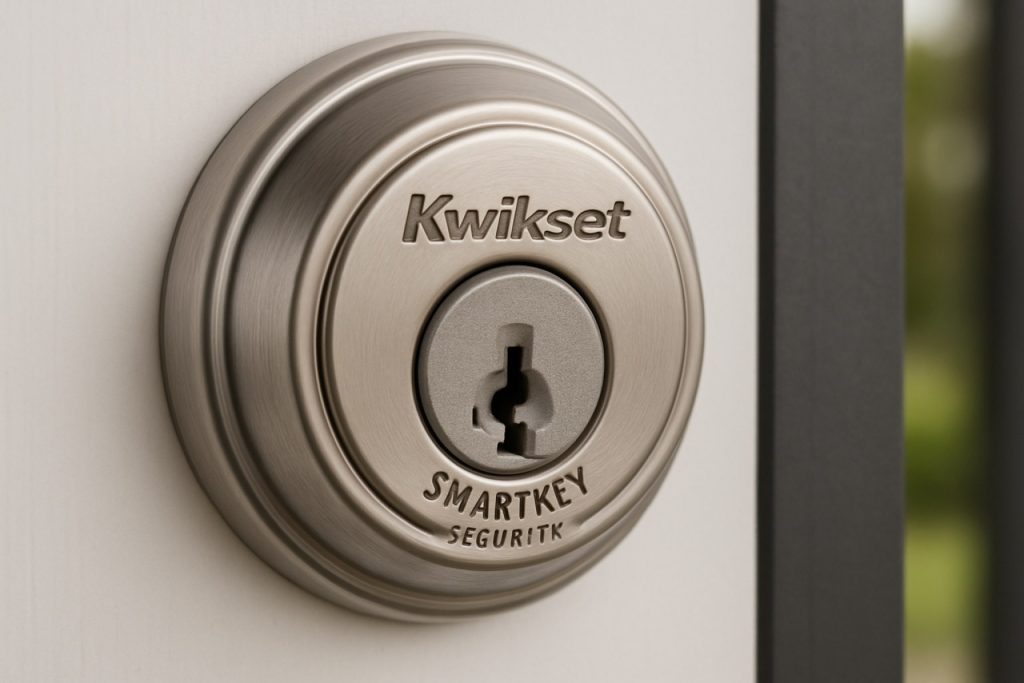
Unlocking the Future: How Kwikset SmartKey Security is Redefining Home Safety. Discover the Technology, Benefits, and Market Impact of This Revolutionary Lock System. (2025)
- Introduction to Kwikset SmartKey Security
- Core Technology: How SmartKey Works
- Comparative Security: SmartKey vs. Traditional Locks
- Re-Keying Made Simple: The User Experience
- Vulnerabilities and Security Testing
- Integration with Smart Home Ecosystems
- Market Adoption and Consumer Trends (Estimated 15% Growth in 2024)
- Regulatory Standards and Certifications
- Future Innovations and Roadmap
- Conclusion: The Outlook for SmartKey Security in Home Protection
- Sources & References
Introduction to Kwikset SmartKey Security
Kwikset SmartKey Security is a patented lock technology developed by Kwikset, a leading manufacturer of residential locks and door hardware in North America. Introduced to address both security and convenience, SmartKey Security allows homeowners to re-key their locks quickly and easily without removing the lock from the door. This innovation is particularly significant in the context of modern home security, where flexibility and protection against common break-in methods are paramount.
The core feature of Kwikset SmartKey Security is its re-key technology, which enables users to reset their lock to work with a new key in a matter of seconds. This is accomplished using a special tool provided with the lock, eliminating the need for professional locksmith services. The system is designed to be user-friendly, making it accessible for a wide range of consumers, including those with minimal technical expertise.
In addition to convenience, SmartKey Security is engineered to provide enhanced protection against prevalent forms of forced entry, such as lock picking and bumping. The technology incorporates a unique locking mechanism that resists these techniques, offering a higher level of security compared to traditional pin-and-tumbler locks. According to Kwikset, SmartKey Security meets or exceeds the most stringent residential security standards, including those set by the American National Standards Institute (ANSI) and Builders Hardware Manufacturers Association (BHMA).
As of 2025, Kwikset SmartKey Security is widely available across a variety of lock types, including deadbolts, lever handles, and electronic smart locks. The technology is integrated into many of Kwikset’s product lines, reflecting the company’s commitment to innovation and consumer safety. Kwikset, a subsidiary of Spectrum Brands Holdings, Inc., continues to invest in research and development to further enhance the security and usability of its products.
The adoption of SmartKey Security has been driven by growing consumer awareness of home security risks and the desire for solutions that combine robust protection with ease of use. As smart home technology evolves, Kwikset’s SmartKey Security remains a foundational element in the company’s approach to safeguarding residential properties, providing homeowners with both peace of mind and practical flexibility.
Core Technology: How SmartKey Works
Kwikset SmartKey Security is a patented lock technology designed to provide homeowners with enhanced security and convenience. At its core, SmartKey utilizes a unique locking mechanism that differs significantly from traditional pin-and-tumbler systems. Instead of relying solely on pins, SmartKey employs a sidebar locking system, which increases resistance to common forms of lock manipulation such as picking and bumping. This sidebar mechanism interacts with specially designed wafers inside the lock cylinder, ensuring that only the correct key can align the components and allow the lock to turn.
One of the hallmark features of SmartKey Security is its re-keying capability. Homeowners can re-key their locks in seconds without removing the lock from the door or using specialized tools. This is accomplished through a simple three-step process: inserting the current key, using the SmartKey Learn Tool, and then inserting a new key. The lock’s internal mechanism is reset to recognize the new key, rendering the old one obsolete. This feature is particularly valuable for situations such as moving into a new home, lost keys, or tenant turnover, as it eliminates the need for professional locksmith services or complete lock replacement.
The SmartKey system also incorporates advanced security features to address vulnerabilities found in conventional locks. The sidebar and wafer design makes it highly resistant to lock bumping—a technique where a specially cut key is used to force open a lock. Additionally, the lock’s internal components are engineered to withstand torque attacks and other forced entry methods. Kwikset, a leading manufacturer of residential locks and a subsidiary of Spectrum Brands, has subjected SmartKey Security to rigorous testing, including certification to the highest residential security standards set by organizations such as the American National Standards Institute (ANSI) and the Builders Hardware Manufacturers Association (BHMA).
In summary, the core technology behind Kwikset SmartKey Security is its innovative sidebar locking mechanism, which not only enhances protection against unauthorized entry but also empowers users with the ability to quickly and easily re-key their locks. This combination of security and convenience has made SmartKey a popular choice for modern homeowners seeking reliable and adaptable door hardware solutions.
Comparative Security: SmartKey vs. Traditional Locks
Kwikset SmartKey Security represents a significant evolution in residential lock technology, offering features that distinguish it from traditional pin-and-tumbler locks. The core innovation of SmartKey lies in its unique locking mechanism, which utilizes a sidebar and wafer design rather than the conventional pin stacks. This design provides several comparative advantages and some considerations when evaluated against traditional locks.
One of the primary security benefits of Kwikset SmartKey is its resistance to common forced entry techniques. Traditional locks are often vulnerable to lock picking and bumping—methods that exploit the alignment of pins within the cylinder. In contrast, SmartKey’s sidebar mechanism is specifically engineered to resist these attacks, making unauthorized entry significantly more difficult. According to Kwikset, the SmartKey system has been tested to withstand advanced picking and bumping attempts, offering a higher level of protection for homeowners.
Another notable feature is the re-keying capability. With traditional locks, re-keying typically requires disassembling the lock or hiring a locksmith. SmartKey Security allows users to re-key their locks quickly and easily using a special tool, without removing the lock from the door. This feature is particularly advantageous for property managers or homeowners who need to change keys frequently, enhancing both convenience and security.
However, comparative studies and security assessments have highlighted some considerations. While SmartKey locks are highly resistant to picking and bumping, they are not impervious to all forms of attack. Physical force, such as torque attacks or destructive entry, can still compromise the lock if sufficient effort is applied. Traditional locks, depending on their grade and construction, may offer varying degrees of resistance to such brute-force methods. It is important to note that both SmartKey and traditional locks are subject to the standards set by the American National Standards Institute (ANSI), which grades locks based on durability and security.
- SmartKey Security: Superior resistance to picking and bumping, easy re-keying, innovative sidebar design.
- Traditional Locks: Widely used, variable security based on design and grade, re-keying requires more effort.
In summary, Kwikset SmartKey Security offers enhanced protection against certain attack methods and greater user convenience compared to traditional locks. However, as with any security device, it is most effective when used as part of a comprehensive home security strategy and when installed according to manufacturer guidelines.
Re-Keying Made Simple: The User Experience
Kwikset SmartKey Security has revolutionized the process of re-keying residential locks, making it accessible and convenient for homeowners without the need for professional locksmith services. Traditionally, re-keying a lock required disassembling the lock cylinder and replacing internal pins—a process that could be time-consuming, technical, and often necessitated specialized tools. With SmartKey Security, Kwikset has introduced a patented technology that allows users to re-key their locks in a matter of seconds, using only the current working key, a new key, and the SmartKey Learn tool.
The user experience is designed to be intuitive and secure. To re-key a SmartKey lock, the homeowner simply inserts the current key, rotates it 90 degrees, inserts the SmartKey tool into the designated slot, removes the old key, and then inserts the new key. After turning the new key back to the original position and removing it, the lock is now re-keyed to the new key. This process eliminates the need to remove the lock from the door or to have any advanced mechanical knowledge, making it especially appealing for those who frequently need to change keys, such as landlords or homeowners who have lost a key or experienced a security concern.
Kwikset, a leading manufacturer of residential locks and security products, emphasizes that SmartKey Security is not only about convenience but also about maintaining a high level of security. The SmartKey system is engineered to resist common forms of lock attacks, such as picking and bumping, while still allowing for the easy re-keying feature. This balance of user-friendly design and robust security is a key differentiator in the market. According to Kwikset, the SmartKey mechanism has undergone rigorous testing to meet or exceed industry standards for residential security.
For users, the ability to re-key a lock quickly can provide peace of mind in situations such as moving into a new home, after a roommate moves out, or following a lost or stolen key. The process is also cost-effective, as it removes the need for professional locksmith fees or purchasing entirely new locksets. The SmartKey Security system is compatible with a wide range of Kwikset products, further enhancing its appeal and flexibility for different door types and security needs.
In summary, Kwikset SmartKey Security’s re-keying feature exemplifies how modern lock technology can empower users with both control and confidence in their home security, all while simplifying what was once a complex and technical task.
Vulnerabilities and Security Testing
Kwikset SmartKey Security is a widely adopted residential lock technology designed to offer enhanced protection and user convenience through its rekeyable cylinder system. However, like all security products, it has been subject to scrutiny regarding potential vulnerabilities and the effectiveness of its security features. Understanding these vulnerabilities and the results of independent security testing is crucial for consumers and industry professionals alike.
The SmartKey system utilizes a unique sidebar locking mechanism, which differs from traditional pin-and-tumbler designs. This innovation was intended to resist common attacks such as lock picking and bumping. According to Kwikset, the SmartKey Security locks are certified to meet the highest residential security standards, including the ANSI/BHMA Grade 1 certification for select models. This certification, issued by the Builders Hardware Manufacturers Association (BHMA), indicates that the lock has passed rigorous mechanical and security tests, including resistance to picking, drilling, and physical force.
Despite these certifications, independent security researchers and locksmith organizations have identified vulnerabilities in earlier versions of the SmartKey system. Notably, in 2008, researchers demonstrated that the original SmartKey design could be bypassed using specialized tools that exploited the lock’s internal mechanisms. In response, Kwikset updated the SmartKey design, introducing additional security features to address these weaknesses. The company now claims that the current generation of SmartKey Security locks is highly resistant to both picking and bumping, and that the rekeying process itself does not introduce new vulnerabilities.
Security testing by organizations such as the Builders Hardware Manufacturers Association and the American National Standards Institute (ANSI) involves standardized procedures to evaluate lock performance under various attack scenarios. These tests include torque resistance, impact resistance, and attempts to manipulate the locking mechanism. While SmartKey Security locks have passed these industry-standard tests, it is important to note that no lock is entirely impervious to attack. Physical security experts recommend that SmartKey locks be used as part of a layered security approach, combining robust hardware with other protective measures.
In summary, Kwikset SmartKey Security has evolved in response to identified vulnerabilities, and its current models are certified to meet stringent industry standards. Ongoing security testing by recognized authorities helps ensure that these locks provide a high level of protection for residential applications, though users should remain aware of the limitations inherent to any mechanical locking system.
Integration with Smart Home Ecosystems
Kwikset SmartKey Security is a proprietary lock technology developed by Kwikset, a leading manufacturer of residential locks and door hardware. One of the key advantages of Kwikset SmartKey Security is its compatibility with a wide range of smart home ecosystems, enabling users to integrate physical security with digital convenience. This integration is particularly relevant as smart home adoption continues to rise, with homeowners seeking seamless control over access and automation.
Kwikset offers several smart lock models equipped with SmartKey Security, such as the Halo, Premis, and Obsidian series. These devices are designed to work with major smart home platforms, including Amazon Alexa, Google Assistant, and Apple HomeKit. For example, the Kwikset Premis lock is certified for Apple HomeKit, allowing users to control and monitor their locks using the Apple Home app or Siri voice commands. Similarly, the Halo series supports Wi-Fi connectivity, enabling remote access and integration with Amazon Alexa and Google Assistant for voice-activated locking and unlocking.
Integration with these ecosystems is facilitated through wireless communication protocols such as Wi-Fi, Zigbee, and Z-Wave, depending on the specific Kwikset model. This allows users to incorporate Kwikset SmartKey-enabled locks into broader home automation routines, such as automatically locking doors when a security system is armed or receiving real-time notifications when someone enters or exits the home. The ability to re-key locks quickly and securely, a hallmark of SmartKey Security, further enhances the flexibility of these integrations, as homeowners can easily update access credentials without replacing hardware.
Kwikset’s commitment to interoperability is underscored by its participation in industry alliances and certification programs. The company is a member of the Connectivity Standards Alliance (formerly Zigbee Alliance), which promotes open standards for smart home devices. This involvement ensures that Kwikset products remain compatible with evolving smart home protocols and can be integrated with a growing array of third-party devices and platforms.
In summary, Kwikset SmartKey Security’s integration with leading smart home ecosystems provides homeowners with enhanced security, convenience, and flexibility. By supporting multiple communication standards and partnering with major technology platforms, Kwikset enables users to manage access and monitor their homes as part of a unified smart home experience.
Market Adoption and Consumer Trends (Estimated 15% Growth in 2024)
Kwikset SmartKey Security has experienced notable market adoption in recent years, with consumer trends indicating a strong preference for advanced, user-friendly residential security solutions. As of 2024, the adoption rate of SmartKey-enabled locks is estimated to have grown by approximately 15%, reflecting both increased consumer awareness and the expanding smart home market. This growth is driven by several factors, including heightened concerns about home security, the convenience of re-keying technology, and the integration of smart lock features compatible with home automation systems.
Kwikset, a leading manufacturer of residential locks and door hardware, introduced SmartKey Security to address vulnerabilities in traditional pin-and-tumbler locks. The technology allows homeowners to re-key their locks quickly and securely without removing the lock from the door, providing flexibility for situations such as lost keys or changes in occupancy. This feature has resonated with consumers seeking both security and convenience, contributing to the widespread adoption of SmartKey products. According to Kwikset, SmartKey Security is designed to resist common break-in methods such as lock picking and bumping, further enhancing its appeal among safety-conscious buyers.
Consumer trends in 2024 also show a growing demand for smart home integration. Many of Kwikset’s SmartKey-enabled locks are compatible with popular smart home platforms, allowing users to control access remotely and monitor entry activity. This aligns with broader trends in the residential security market, where homeowners increasingly prioritize products that offer both physical and digital security features. The ability to re-key locks without professional assistance also appeals to property managers and landlords, who benefit from the cost savings and operational efficiency.
The estimated 15% growth in 2024 can be attributed to Kwikset’s ongoing innovation, strategic partnerships with homebuilders, and expanded retail presence. The company’s commitment to educating consumers about the benefits of SmartKey Security—through online resources, in-store demonstrations, and partnerships with organizations such as the Builders Hardware Manufacturers Association—has further fueled adoption. As the smart home ecosystem continues to evolve, Kwikset’s SmartKey Security is well-positioned to maintain its momentum, meeting the needs of a diverse and security-conscious customer base.
Regulatory Standards and Certifications
Kwikset SmartKey Security locks are designed to meet rigorous regulatory standards and certifications that ensure their reliability, safety, and resistance to common forms of attack. In the United States, residential door hardware is often evaluated against standards set by the American National Standards Institute (ANSI) and the Builders Hardware Manufacturers Association (BHMA). These organizations establish grading systems—Grade 1, Grade 2, and Grade 3—based on factors such as durability, security, and operational performance. Kwikset SmartKey products are typically certified to at least ANSI/BHMA Grade 1 or Grade 2, indicating high levels of security and durability suitable for residential use.
A key regulatory focus for SmartKey Security is resistance to lock picking and bumping, two common methods of forced entry. The SmartKey cylinder incorporates a patented sidebar locking mechanism, which is specifically engineered to resist these attacks. This design has been tested and certified to meet or exceed the stringent requirements outlined in ANSI/BHMA standards for pick and bump resistance. Additionally, Kwikset SmartKey locks are often subjected to third-party testing to validate their compliance with these standards, providing consumers with independent assurance of their security claims.
In Canada, similar standards are enforced by the Standards Council of Canada (SCC), which recognizes ANSI/BHMA certifications for imported and domestically produced locks. This harmonization of standards across North America ensures that Kwikset SmartKey Security products meet consistent benchmarks for quality and safety in both countries.
Beyond North America, Kwikset’s parent company, ASSA ABLOY, is a global leader in access solutions and adheres to international standards such as those set by the International Organization for Standardization (ISO). While specific ISO standards for mechanical locks (such as ISO 9001 for quality management systems) may apply, the primary focus for residential locks remains compliance with ANSI/BHMA and equivalent national standards.
In summary, Kwikset SmartKey Security locks are engineered and certified to meet or exceed the leading regulatory standards in the industry. Their compliance with ANSI/BHMA and SCC requirements, as well as alignment with global best practices through ASSA ABLOY, underscores their commitment to providing secure and reliable locking solutions for residential applications.
Future Innovations and Roadmap
Kwikset SmartKey Security has established itself as a leading technology in residential and light commercial lock security, offering re-keyable cylinders and advanced resistance to common break-in methods. Looking ahead to 2025, the future innovations and roadmap for Kwikset SmartKey Security are shaped by evolving consumer demands for convenience, integration, and enhanced protection.
A key area of innovation is the integration of SmartKey Security with smart home ecosystems. As the adoption of connected devices accelerates, Kwikset is expected to further expand compatibility with major smart home platforms, such as those from Apple, Amazon, and Google. This will likely include deeper support for voice assistants, remote access, and automation, allowing users to manage their locks seamlessly alongside other smart devices. Enhanced mobile app experiences, with real-time notifications and advanced user management, are anticipated to become standard features.
Security remains at the forefront of Kwikset’s roadmap. The company is committed to ongoing research and development to address emerging threats, such as sophisticated lock-picking tools and cyber vulnerabilities. Future iterations of SmartKey Security are expected to incorporate improved materials, more complex keyways, and advanced anti-tamper mechanisms. Additionally, Kwikset is likely to invest in third-party certifications and testing, working closely with organizations like American National Standards Institute (ANSI) and UL Solutions to ensure compliance with the latest security standards.
Sustainability and user-centric design are also influencing the future direction of SmartKey Security. Kwikset is exploring eco-friendly manufacturing processes and recyclable materials to reduce environmental impact. Ergonomic improvements, such as easier re-keying procedures and accessible design for users with disabilities, are anticipated to be part of upcoming product lines.
Finally, Kwikset’s roadmap includes expanding the SmartKey Security portfolio to new markets and applications. This may involve developing solutions tailored for multi-family housing, small businesses, and property management, where scalable access control and rapid re-keying are critical. By leveraging its parent company’s resources—Spectrum Brands—Kwikset is well-positioned to innovate and respond to the dynamic needs of the security industry in 2025 and beyond.
Conclusion: The Outlook for SmartKey Security in Home Protection
As we look ahead to 2025, Kwikset SmartKey Security continues to play a significant role in the evolution of residential security solutions. This technology, developed by Kwikset, a leading manufacturer of residential locks in North America, has established itself as a reliable and innovative option for homeowners seeking both convenience and enhanced protection. The SmartKey system’s unique re-keying capability allows users to quickly and easily reset their locks without removing them from the door, addressing common concerns about lost or stolen keys and facilitating seamless transitions for new occupants.
The security features of SmartKey, including its resistance to common forced entry techniques such as lock picking and bumping, have been independently tested and certified to meet stringent industry standards. For example, many SmartKey products are certified to ANSI/BHMA Grade 1 or 2, reflecting their durability and security performance as recognized by the Builders Hardware Manufacturers Association, a key standards organization in the hardware industry. This level of certification provides homeowners with confidence that their locks are designed to withstand sophisticated attacks, a critical consideration as burglary methods continue to evolve.
Looking forward, the integration of SmartKey Security with smart home ecosystems is expected to further enhance its value proposition. As connected devices become more prevalent, Kwikset has expanded its product line to include smart locks that combine SmartKey technology with features such as remote access, user management, and integration with platforms like Z-Wave and Zigbee. This convergence of mechanical and digital security enables homeowners to monitor and control access to their homes from anywhere, increasing both convenience and peace of mind.
However, as with any security technology, ongoing vigilance is necessary. Kwikset and other industry leaders must continue to invest in research and development to address emerging threats and vulnerabilities. The company’s commitment to innovation and adherence to industry standards suggest that SmartKey Security will remain a trusted choice for home protection in the years ahead. Ultimately, the outlook for SmartKey Security is positive, with its blend of user-friendly features, robust physical security, and adaptability to smart home trends positioning it as a cornerstone of modern residential security solutions.
Sources & References
- Kwikset
- American National Standards Institute
- Builders Hardware Manufacturers Association
- Kwikset
- Connectivity Standards Alliance
- American National Standards Institute
- Builders Hardware Manufacturers Association
- Standards Council of Canada
- ASSA ABLOY
- International Organization for Standardization
- Apple
- Amazon
- Spectrum Brands



